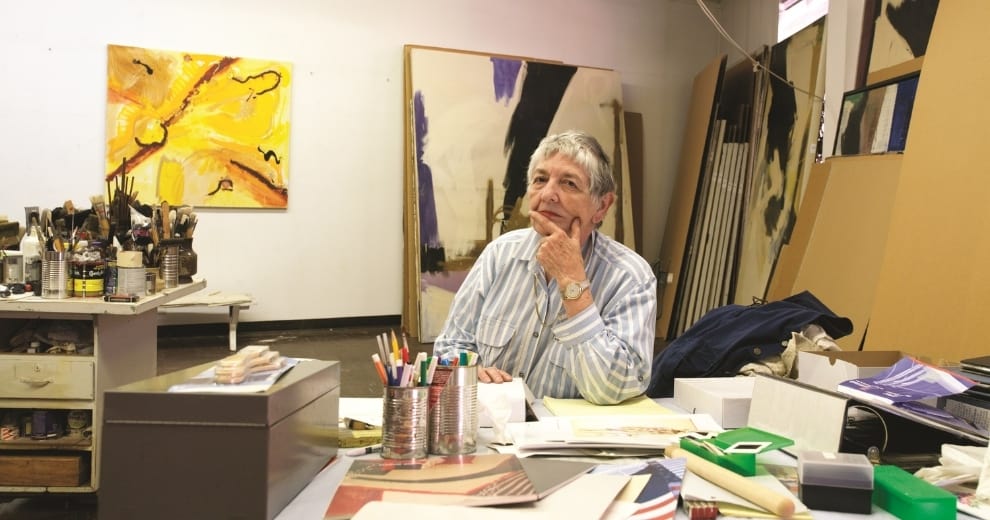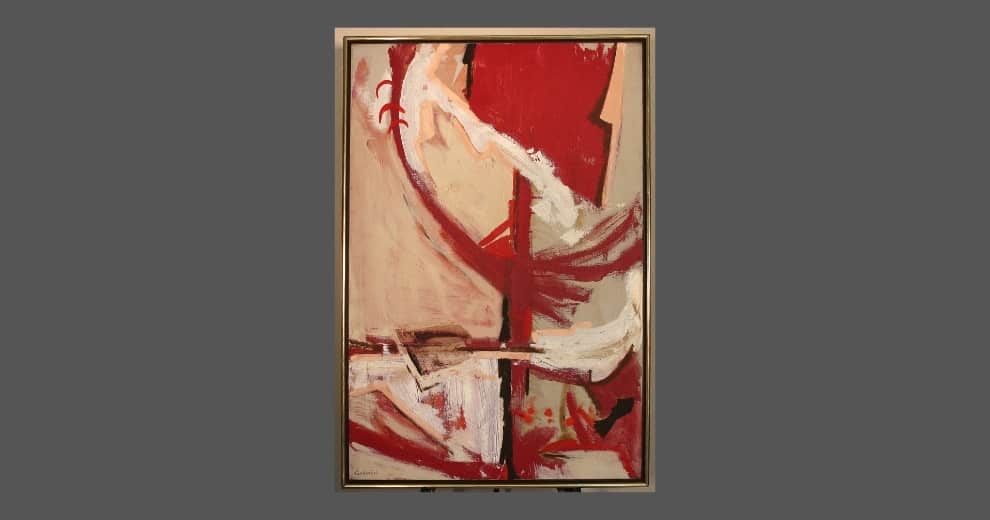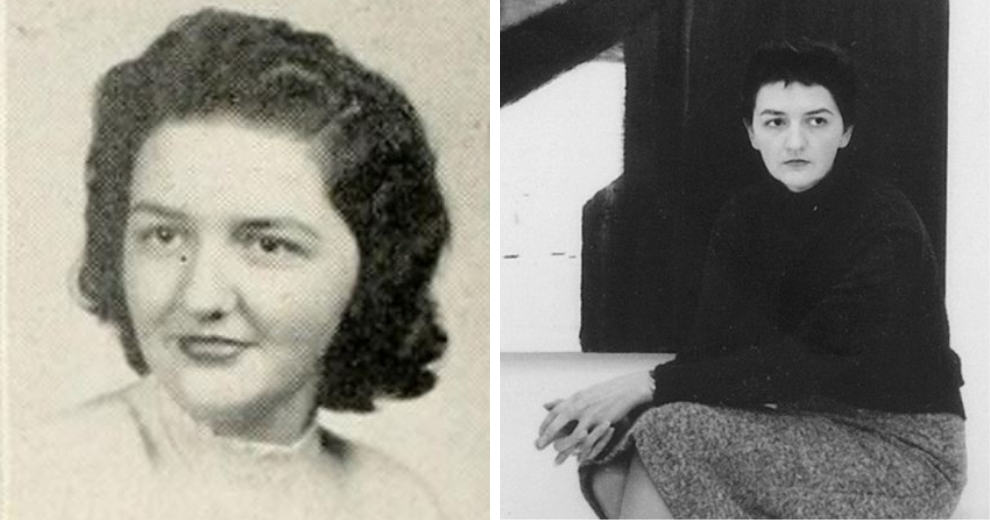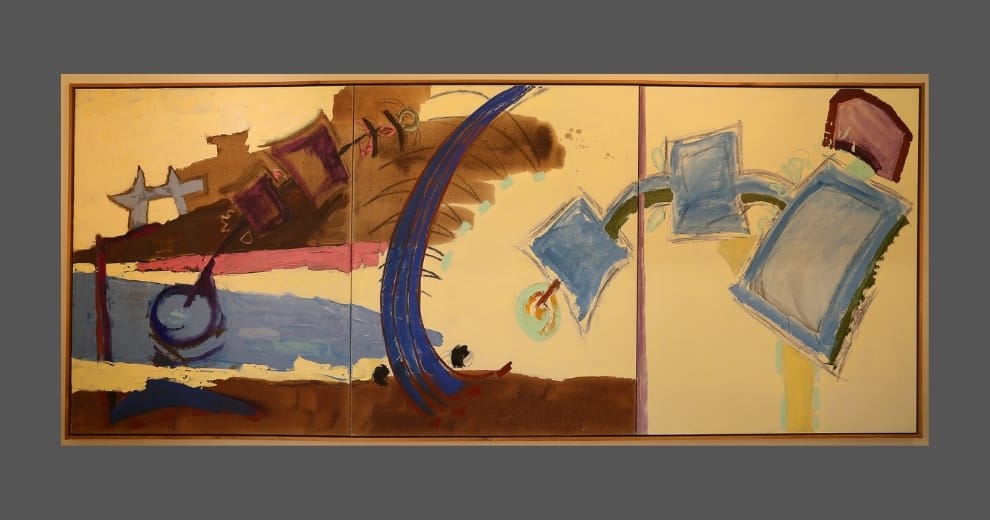Mary Baldwin University honors the life of Judith Godwin ’52, who achieved international significance as a contemporary painter based primarily in New York City. She passed away on May 29 at 91 after forging a 70-year career as an artist.
An innovative and important member of Abstract Expressionism, Godwin created bold, vivid works that “emphasize what is important by painting the image of my feelings on canvas—to accept my feelings honestly, and not [to] falsify,” as she described in a past interview.
Her paintings are included in more than 50 leading museum collections including the Metropolitan Museum of Art and the Museum of Modern Art in New York City, and have been featured in solo and group exhibitions around the world.

Thanks to Godwin’s generosity, MBU holds two of her works in its collection: “Red Flurry” and the large three-panel piece “Oriental Circus,” which are both displayed at MBU’s Murphy Deming College of Health Sciences in Fishersville.
University President Pamela R. Fox shares the following tribute to Godwin and her significant contributions to contemporary art:
“It was one of the honors of my career to have known Judith well, and I enjoyed many visits with her in her home and studio in New York City, especially in conversations in her rooftop garden lovingly tended overlooking Manhattan. She was a force of imagination and independence. On my first visit, she unfolded in engaging detail her time at Mary Baldwin College in the early 1950s, particularly the visit of remarkable American dancer and choreographer Martha Graham. Godwin was inspired by Graham, and this catalyst sparked to flame her fierce determination and artistic passion. She fought her way in the 1950s and 60s art world, often feeling overlooked or sidelined, but make no mistake — Judith was a pioneer of Abstract Expressionism, not just women in Abstract Expressionism. In her studio, she led me through scores of her major works, explaining her inspiration and hopes that her works would eventually be more widely recognized. She was forthright and brutally frank, refreshingly penetrating in issuing insightful comments. I learned a great deal from her and look forward to her work taking up its more widely recognized recognition and reputation.”
“Judith fought her way in the 1950s and 60s art world, often feeling overlooked or sidelined, but make no mistake — she was a pioneer of Abstract Expressionism, not just women in Abstract Expressionism. ”
President Pamela R. Fox
Mary Baldwin as inspiration and connection
A native of Suffolk, Godwin came to Mary Baldwin in 1948 with the Class of 1952, and studied with noted artists and professors Elizabeth Nottingham and Horace Day, who often updated their students with developments in New York City’s contemporary art scene.
Godwin also helped coordinate a performance at Mary Baldwin by famed dancer and choreographer Martha Graham and her company, who were on tour at the time. The two met on campus and had a long conversation during which Graham encouraged her interest in the expressive arts. Later in New York, the two women became good friends.
To pursue her growing interest in painting, Godwin left Mary Baldwin in 1950 and entered the Richmond Professional Institute of the College of William and Mary — now Virginia Commonwealth University (VCU) — where she earned her bachelor of fine arts in 1953.
Godwin remained a dedicated supporter of the university, giving faithfully to the annual fund each year, serving on the Board of Trustees from 1984 to 1989, sharing her paintings in exhibitions at Hunt Gallery, and consulting on the university’s permanent collection.
Godwin remained a dedicated supporter of the university, giving faithfully to the annual fund each year, serving on the Board of Trustees from 1984 to 1989, sharing her paintings in exhibitions at Hunt Gallery, and consulting on the university’s permanent collection.

“Red Flurry” by Judith Godwin (1994, oil on canvas, 36”x24”), part of MBU’s collection. Painting shown on a gray background.
“I met Judith my first year at Mary Baldwin, back in 1992, when she was visiting campus, and I invited her to speak with one of my upper-level drawing classes,” remembered Professor Emeritus of Art Paul Ryan. “Since then we stayed in touch, with Judith sometimes very generously calling me out of the blue to say hi, to inquire about my studio practice, my teaching, my family, Mary Baldwin, and sometimes to congratulate me on an exhibition I was in. It was always an experience to talk with Judith, and I felt honored that she considered me a friend.”
Committed to the ideals of education, Godwin made significant efforts to ensure a vital, creative atmosphere of learning for students.
“She loved the university and wanted to keep a strong connection,” Ryan said. “Her deep artistic and professional connection with Abstract Expressionism, and her contributions to this movement — one of the great art movements of the 20th century — is significant and something that MBU can take great pride in.”
In recognition of her devotion and remarkable accomplishments, Godwin received an honorary doctor of humane letters from Mary Baldwin at the 2003 Commencement ceremony.
“Her deep artistic and professional connection with Abstract Expressionism, and her contributions to this movement — one of the great art movements of the 20th century — is significant and something that MBU can take great pride in.”
Professor Emeritus of Art Paul Ryan

Judith Godwin pictured in the 1949 Bluestocking, Mary Baldwin’s yearbook, (left) and ten years later in 1959 (right)
Coming of age as a painter in New York
After completing her college education, Godwin moved in 1953 to Greenwich Village in Manhattan, which had become an international center for artists, particularly those who stressed originality. The group became known as Abstract Expressionists, or more specifically the New York School, with Hans Hoffman and Franz Kline among the first prominent members.
“My former colleague and his wife Professors Paul Ryan and Dinah Ryan kindly invited me to join them to visit with Judith in her apartment in New York City many years ago,” remembered MBU Associate Professor of Art Jim Sconyers. “I recall her bringing our attention to Franz Kline’s old studio visible from her apartment window. We had a lovely visit, and I will always treasure the opportunity to meet her.”
In her early years as an artist, Godwin became a member of the Art Students League and studied with Hoffman both in New York and Provincetown, Massachusetts. He encouraged her to pursue Abstract Expressionism, and Godwin became one of the only women to challenge what was a male-dominated movement.
“As a student and young artist, she participated in the second generation’s task of building on and sometimes transforming the aesthetic practices of the New York School that had relatively quickly become canonized by the art world,” wrote Ryan in a 1998 article on Godwin in the Mary Baldwin Magazine. “Godwin, as represented by her paintings from 1955–60, began to speak relatively early in her own voice.”
Meaning and legacy through art
Paintings in the Abstract Expressionist style transport the viewer into the artist’s mind and emotional state. Connecting moment to moment and year to year, Godwin’s body of work tells her personal and unique story.
“Her early work is bold, dark, and aggressive, reflecting the battle to be noticed and appreciated in a male-dominated profession,” reads her obituary. “Her later work is more colorful and playful as successes mounted and relationships became more stable.”

“Oriental Circus” by Judith Godwin (1986, oil on canvas, 50″x126″), part of MBU’s collection. Painting shown on a gray background.
Public attention and press coverage focused more on Godwin’s male peers during the mid-to-late 20th century, but she and other women artists of her generation have become increasingly acknowledged and celebrated in their own right. A groundbreaking 2016 exhibition, Women of Abstract Expressionism, at the Denver Art Museum featured Godwin’s work among 11 other women artists.
Painting — as Godwin said in a past interview — “is an act of freedom and a realization that images generated by the female experience can be a powerful and creative expression for all humanity.”
In addition to MoMA and the Met, her work is in the collections of the San Francisco Museum of Modern Art, the National Gallery of Art and the Hirshhorn Museum in Washington, D.C., the Virginia Museum of Fine Arts in Richmond, the Japanese National Museum of Art, the National Museum of Wales, the Suffolk Museum, and many more.
Godwin also had solo and group exhibitions in museums and galleries across the United States including Betty Parson’s Section Eleven in New York — where she was the youngest woman to be invited to join — the McNay Art Museum in San Antonio, the Anderson Gallery-Virginia Museum of Fine Arts joint exhibit, and her most recent at the Berry Campbell Gallery in New York, where she is represented.
“Judith will be greatly missed by many,” said Ryan. “I am filled with sadness at her passing, but also pay tribute to Judith’s artistry, her toughness, and her wonderful sense of humor.”

Judith Godwin’s paintings join the sunshine and students in the atrium at MBU’s Murphy Deming College of Health Sciences.
Read more about Godwin’s work and life
Obituary in the Suffolk News-Herald
Tribute story in Artforum
Artist profile and works from the Berry Campbell Gallery
Professor Emeritus of Art Paul Ryan’s full essay from the 1998 Mary Baldwin Magazine